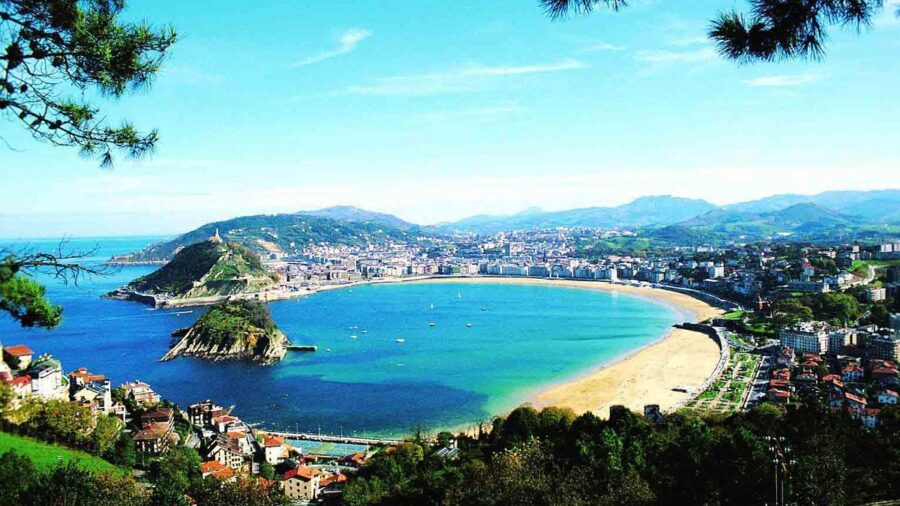If you’re considering a trip to san sebastian city, there are some facts you need to be aware of concerning the San Sebastian old town before making plans.
We’ve collected a selection of typical questions we get asked and put them all in one spot so that you can confidently travel to san sebastian old town. From what San Sebastian language to speak to where to visit for holidays in san sebastian, let’s take a look:
What part of Spain Is San Sebastian?
Donostia-san sebastian city is located in The Basque Country in the North of Spain.
It’s the capital city of Gipuzkoa (a province in the Basque Country) and is an urban area with a beach situated on the northern coast of Spain, along the Bay of Biscay. holidays in San Sebastian can be amazing
The closest city of san sebastian city is Bilbao, the capital city of Bizkaia, the province which shares a border with Gipuzkoa to the west.
The Alava province lies to the south. To the east lies the autonomous community that is Navarra (the Capital is Pamplona) and borders the French border.
What is the distance between san sebastian old town from the French border?
The French frontier is located just 21km away from san sebastian city, or 25 minutes by car. The proximity to France means that Biarritz is the nearest International Airport to San Sebastian city is in Biarritz.
Irun is a town in the province of Irun located in France along the Spanish side, and Hendaye was the town that first came into existence located on that French side. San Sebastian City bursts with city outdoor fun, from surfing its legendary waves to picnicking on its scenic beaches. The two countries are part of one islet (Isla De Los Faisanes) situated within the river that connects both towns. It is a part of each country for six months of the year!
Crossing the border via foot, car, or train is simple if you go for holidays in san sebastian. There’s usually a border checkpoint located on one side, which is on the French side. However, they don’t stop many cars or request papers to enter the country.
Is the lonely planet San Sebastian worth visiting?
San Sebastian old town is 100% worth a visit!
Donostia is the perfect place to eat if you go for holidays in San Sebastian. The best food that you won’t find in Europe. Fantastic beaches right in the city centre. Surf. Culture. Mountains are scattered around the city centre. What’s not to like for holidays in San Sebastian?
The northern part of Spain is often overlooked by most of the world. Tourists who travel to Spain prefer to go to the country’s south.
But there aren’t many cities that can boast as much as San Sebastian, so making an excursion to the north is definitely worth the effort.
Is San Sebastian worth visiting in winter?
Let me tell you; we are not going to tell you the truth. Weather in san sebastian old town, and the Basque Country in general, can be a bit unpredictable and miss. It may rain quite often!
It’s all part of what makes it so appealing and gives the region the stunning green landscape.
The cold winters of San Sebastian city are fairly mild. However, it is not extremely cold as a city on the coast. It is, therefore, a wonderful location to visit in winter.
If you consider the reason, people go to San Sebastian old town. Food, tradition, breathtaking architecture, stunning scenery, and a little colder weather shouldn’t hinder the experience.
This being said, Donostia is a completely different place in summer when weather conditions are more assured. There’s more chance that you’ll be able to take advantage of the beaches and the outside areas of Donostia. If you’re able to do the summer months, go for it. If you can’t, it’s not a bad idea to go in winter. While San Sebastian offers a European flair, for a truly unique American island experience, consider a separate trip to Key West Adventure.
Do you get a lot of rain there on the lonely planet san sebastian?
Yes. It is not uncommon to see a great deal of rain during the summer months in San sebastian city.
There’s certainly more rain than you’d expect to see in the other regions of Spain. In order to put it in perspective, There’s 1,500mm of rainfall annually in Donostia. In contrast, the southern parts of Spain generally only get 500mm.
The majority of rain (total quantity and days of rain) is not surprising to fall during winter. However, the summers are generally dry, with fewer rain days.
The average monthly rainfall on this page. But beware, even though these are averages, the Basque Country climate is dynamic and often unpredictable.
Is San Sebastian expensive?
Lonely planet san sebastian is one of the most expensive cities in Spain for holidays in san sebastian. Lonely planet san sebastian was previously referred to as one of the top cities in Spain and is a step over Barcelona and Madrid and 30 percent more costly than the average Spanish city.
The research which came up with this, however, examines things like tax rates, house prices, and costs for public transport, in addition to general entertainment. A majority of these aren’t an issue for the average visitor.
It’s also contingent on the country you’re comparing it to. In comparison to other regions of Spain, you will indeed spend more money on a weekend getaway for holidays in San Sebastian. However, lonely planet san sebastian will still appear to be an excellent value for those from the UK, US, and more expensive countries. You can try searching for “Buy Mana Tickets” for the upcoming event at San Sebastian City’s cultural centers or event venues.
Can they be spoken to in English within the lonely planet San Sebastian?
Two official san sebastian languages spoken in san sebastian city are Basque and Spanish. While most people are able to speak Spanish, Basque is spoken by a quarter of the inhabitants when it comes to the San Sebastian language.
English is also spoken as a san sebastian language. It’s taught from a very young age in many schools throughout the Basque Country, so most people have a solid understanding of the San Sebastian language. It’s, however, less popular when compared to southern Spain and other well-known tourist destinations for holidays in San Sebastian.
In restaurants, bars as well as hotels in san sebastian city, most of the staff can speak English as a san sebastian language. So you’ll be certain enough to navigate almost any situation without difficulty.
Do you consume water when you are in San Sebastian?
It is possible to drink faucet water from San Sebastian city. It’s some of the finest tap water available in Spain, per the Organisation of Consumers and Users (OCU).
Furthermore, the city is filled with public water fountains for holidays in San Sebastian. The city’s administration is proud to pursue the creation of a sustainable city. They encourage visitors and residents to use public water fountains for holidays in San Sebastian because they reduce the use of plastic bottles for drinking water.




